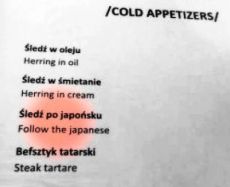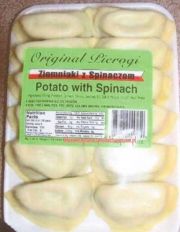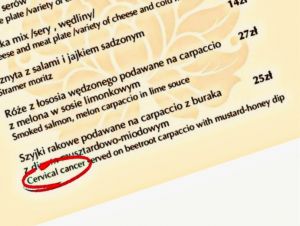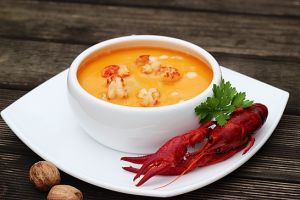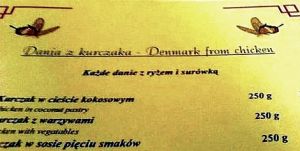Key:A Menu Lost in Translation
Contents
Follow the Japanese
Let’s start with where the confusion came from. The Polish word “śledź”🔊 is the imperative mood of the verb “śledzić”, meaning “to follow”, “to trace” or “to spy”. But it’s also got another meaning, completely unrelated, which would be more fitting in this context: it’s “herring”. So a better translation of “śledź po japońsku” would have been “herring in the Japanese style”. Now what the heck is that?
The “Japanese-style” herring is a very appetising appetiser that was quite popular in Communist Poland. The recipë largely boils down to wrapping a marinated herring fillet around a hard-boiled egg. Perhaps the idea of wrapping a piece of uncooked fish around something reminded one Polish chef of maki sushi rolls, giving rise to its association with Japanese cuisine? Otherwise, this Polish invention has about as much to do with Japan as Hawaiian pizza has to do with Hawaii.
The egg and the fish are typically arranged on a bed of canned green peas laced with mayo and decorated with slices of onions and pickles. The marriage of fishy, salty, sour and fatty flavours means that this simple hors d’œuvre pairs perfectly with a shot of cold neat vodka.
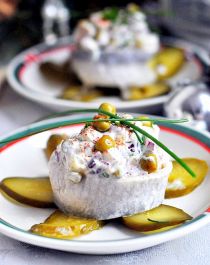
Ingredients (serves 5):
Hard-boil and peel the eggs. Strain the peas. Slice the onion and the cucumbers. Mix the peas with some of the mayonnaise and arrange it on a platter or little plates for individual helpings. Wrap the eggs in herring fillets and place on the bed of peas. Decorate with onion slices powdered with paprika, cucumber slices and squirts of mayonnaise. A single helping should weigh 100 g [3.5 oz], including 20 g [0.7 oz] of herring. | ||||
— Krystyna Flis, Aleksandra Procner: Technologia gastronomiczna z towaroznawstwem, cz. 3, Warszawa: Wydawnictwa Szkolne i Pedagogiczne, 2009, p. 88, own translation
Original text:
|
Dumplings with Spinach and Celebration
After the cold starter it’s time for a hot one: pierogi ze szpinakiem i fetą, or dumplings with spinach and, um… celebration?
Pierogi, the delicious Polish filled and boiled dumplings, often go hand in hand with celebration, fair enough. A platter of pierogi is a must on a Polish Christmas Eve table. In fact, the very word “pierogi” comes from “*pirŭ”, the Proto-Slavic term for a feast. Pierogi are a celebratory food par excellence.
But the spinach in our pierogi wasn’t mixed with feta, the Polish equivalent of a fête, but with feta, the Greek brined cheese. While not as classic as potato-and-cheese, ground-meat or mushroom-and-kraut varieties, spinach combined with feta cheese and some garlic makes another tasty and popular pierogi filling.
And, well, it could have been worse as far as mistranslations go. After all, it’s not only Polish businesses catering to English-speaking patrons that make translation mistakes; the same may happen to U.S. businesses selling supposedly Polish food to Polish Americans. Like the one that confused the Polish words “szpinak” (“spinach”) and “spinacz” (“paper clip”). Office-supplies-filled dumplings, anyone?
Ingredients:
For the filling:
To make the dough: |
| To make the filling: Remove the thicker stems from the leaves and wash the leaves. Press the garlic. Heat olive oil in a pan, add the garlic and sauté on low fire for no more than one minute. Add the spinach, sprinkle with salt and pepper. Continue frying until all the leaves become wilted and the water evaporates. Drain well in a sieve and set aside to cool. […] Transfer onto a board and chop finely. Place the spinach in a bowl, add feta cheese crushed between your fingers and mix well. […] Place the filling inside the dough pockets, seal well and set aside onto a floured kitchen towel. Drop the dumplings into boiling salted water. Continue cooking for 1–2 minutes after they have floated up to the surface. | ||||
— Pierogi ze szpinakiem i fetą, in: Posmakujto, 20 March 2019, own translation
Original text:
|
Cervical Cancer Soup
No Polish dinner is complete without a bowl of soup, so now, after we’ve had our starters, what would you say to the exquisite 19th-century Polish delicacy known as cervical cancer soup? Wait, what?
A British tourist in Poznań who once found another “cervical cancer” dish on the menu had this to say about the experience:
| No one I know has had cervical cancer, but I can imagine that if it had been seen by somebody else, they might have been well upset. As it was, I quickly lost my appetite; the meaning doesn’t exactly encourage you to order anything, does it? |
| — Owen Durray, quoted in: Yusuf Bhana: Polish Restaurant Offers Cervical Cancer on Menu Due to Translation Error, in: TranslateMedia, 3 May 2013 |
The restaurant’s spokesperson said they would be “having a word with [their] translator”. By which, I suppose, they meant they would be trying to hold a conversation with Google Translate.
Let’s see what happened here, step by step. The original Polish name for the key ingredient is “szyjki rakowe”🔊. “Szyjki” could be literally translated as “little necks”, but in this case it refers to crayfish tails (which, technically, are neither tails nor necks, but abdomina). “Rak”, the Polish word for crayfish, is also used for most of the things which the English language refers to by the Latin word for “crab”, that is, “cancer” – such as the Zodiac sign and, yes, the disease too. And specifically, “rak szyjki macicy”, or “cancer of the neck of the womb”, is the Polish medical term for cervical cancer. “Szyjki rakowe” and “rak szyjki” may look and sound similar, but the difference in meaning is that between delicious and disgusting.
In any case, if you’ve never sampled zupa z szyjek rakowych, or crayfish soup (and you still haven’t lost your appetite), then you definitely should give this classic Polish dish a try! Throwing the poor crustaceans live into boiling water may seem cruel, but it’s actually the most humane way of killing them as they die instantly.
Wash and brush the crayfish thoroughly, throw them live into boiling water with salt and dill. Cook under cover for 6 minutes. The crayfish will turn deep red during cooking. Once cooked and chilled, scoop out the meat. […] Bleach almonds with boiling water and remove the skins. Wash rice, cover with boiling water and cook until tender, then strain and place in a pot of poultry broth. Add the crayfish meat, almonds, cream and bring to boil, then mix in yolks, chopped dill and season to taste. | ||||
— Maciej Kuroń: Kuchnia polska: Kuchnia rzeczypospolitej wielu narodów, Jacek Sanatorski, 2004, p. 210, own translation
Original text:
|
Denmark from Chicken
And now for the main course, Denmark from chicken. Is this some kind of Nordic version of chicken Kiev (or is it chicken Kyiv)? Not really. You see, “Dania”🔊 (with capital D) is the Polish name for the country of Denmark. But “dania”🔊 (with lower-case D and a marginally different pronunciation) is the Polish word for dishes or courses. So “dania z kurczaka” is not so much a single preparation as it’s the title of a whole section of a menu, devoted to chicken dishes in general. And it has nothing whatsoever to do with the state of Denmark.
I suppose you still expect a recipë, though, don’t you? Okay, so let’s pick what is perhaps the most Polish chicken dish you can find, which is the kurczę pieczone po polsku, or liver-stuffed roasted chicken in the Polish style.
For the stuffing:
|
|
Wash the chicken, pat dry, rub with salt and set aside in a cool place for 2 hours. Prepare the stuffing: soak a stale kaiser roll in milk, squeeze the milk out and run the roll through a meat grinder together with a washed liver. […] Mix egg yolk with butter or margarine, combine with the roll-and-liver mixture, add parsley, fold in egg white beaten to a froth, season with salt and pepper. Fill the chicken with the stuffing, then truss it with pins or sew it up. Place the chicken in a roasting pan, baste with oil and bake in a preheated oven (200°C [400°F]) for 40–45 minutes. While baking, sprinkle frequently with water and later with pan drippings. Carve into portions, serve along with the stuffing, potatoes and cucumber-and-cream salad. | ||||
— Zofia Surzycka-Mliczewska: Kuchnia polska, Warszawa: Polskie Wydawnictwo Ekonomiczne, 2005, p. 412–413, own translation
Original text:
|
Buckwheat with Cocks Sauce
This one sounds intriguing, doesn’t it? Some older folks in England might remember Cocks’s Reading Sauce. And no, it wasn’t used to make reading about cocks more enjoyable. It was a brand of fish sauce produced in the Berkshire town of Reading by a fishmonger whose name was James Cocks (and his heirs after him). First marketed in 1802, it was made from fermented anchovies, walnut ketchup, mushroom ketchup, soy sauce, salt, garlic and chilli peppers[1] (see my older post for more about the intertwined histories of ketchup and fish sauce). It was soon followed by and for decades competed with similar sauces, also sold in small bottles with orange labels, like the now more famous Worcestershire sauce. But eventually, the production of Reading sauce ended in 1962.[2] So it’s unlikely that this is the sauce that was meant by the menu I once saw in a Polish roadside inn. Besides, while Cocks’s condiment was advertised to go well with “game, wild fowl, hashes, rump steaks and cold meat”,[3] it was never known to be put on heaps of boiled buckwheat.
Back to square one then. A better explanation would be that the “cocks sauce” in the menu was a result of mistranslation. The English word “cocks” has multiple meanings and so do the Polish terms “kury”🔊 and “kurki”🔊. The primary meaning of “cocks” is “male domestic fowl”, also known as “cockerels” or “roosters”. In modern Polish, “kury” refers to hens, but a few centuries ago it meant “roosters” instead. So was the sauce made from the meat of cockerels? Well, no.
Among the many different meanings of the English “cock”, the vulgar term for the male member is particularly well known. The rooster has been a symbol of male virility in many cultures. Among Slavic languages, Bulgarian makes the same association, with “kur” referring to both the cocky bird and a man’s cock (“patka” – literally, “duck” – is another vulgar Bulgarian word for the latter, which makes Bulgarians laugh every time they hear “kuropatka” – which means “partridge” in Russian and “cock-dick” in Bulgarian; gotta love these Slavic false friends). “Kur” also gave rise to the vulgar word for a prostitute (a woman whose job involves handling penes) in all Slavic languages, including Polish. But I digress; the sauce definitely wasn’t made from phalli!
Besides, the Polish word was “kurki”, a diminutive form of “kury”. Depending on the context, it could mean freshly hatched chickens, weathercocks, stopcocks,… But none of these seem to fit in the context of sauce for buckwheat. So what does?
Chanterelles. Small, peppery, trumpet-shaped mushrooms. Their bright yellow colour might remind you of chicks, which explains why “kurki” is the common Polish name for them (see this older post for more about Polish forest mushrooms). So there you have it: kasza z sosem kurkowym is buckwheat with chanterelle sauce.

Recipë and picture from the Polish cooking blog Trzeci Talerz.
Slice garlic cloves and sauté them in butter, then add chopped chanterelles. Add stock and stew the mixture on low fire for about 30 minutes. Blend in cream, which you may first mix with flour to make the sauce thicker. Add salt and pepper to taste. Cook for a few more minutes. Boil buckwheat in salted water […] Serve basted with the sauce and sprinkled with chopped parsley. | ||||
— Kasza gryczana z kurkami – kuchnia podkarpacka, in: Trzeci Talerz: Podkarpacki blog kulinarny, 2018, own translation
Original text:
|
Ice Cream with Barrister
Would you like your lawyer to come along with your order of ice cream? If not, then don’t worry; this is just another botched translation. The original Polish phrase is “lody z adwokatem”, where “adwokat”🔊 is the word that threw the machine translator off. In one sense, it does refer to a lawyer that advocates your case in a court of law, coming from the Latin word “advocatus”, “the one who has been called to one’s aid”.
But in this case, “adwokat” is just a Polonised spelling of the Dutch “advocaat”, which refers to a sweet, smooth, custardy yellow drink made from yolks, sugar and alcohol. Nobody really knows why this egg liqueur is called that. One hypothesis says it was Dutch lawyers’ beverage of choice. But there’s a more curious one, which claims that the name of the drink ultimately comes from a Native American word for testicles.
| When Dutch sailors found this fruit, they found out that “ahuacatl” in the Nahuatl language means “testicles” because they often grew in pairs on the trees and looked like pairs of testicles hanging off the branch. Being cheeky, they decided that they’d tell the people back home that they were called “avocaat”, which was similar to the word for lawyer. Hence we get the drink Advocaat, which was originally made with avocados by Dutch settlers in Recife. |
| — CB27: The pope’s testicles…, in: Quite Interesting, 21 July 2008 |
When the Spaniards (not Dutch) conquered Mexico and discovered the fruit, they assimilated its Nahuatl name, “āhuacatl”, into their own language as “aguacate”. This was later borrowed into French as “avocat” (which incidentally also means “lawyer”) and into English, Dutch and many other European languages as “avocado”.
But there’s quite a lot to unpack here. What does the avocado have to do with an egg-based liqueur? Why did Dutch settlers in Recife, Brazil, make a drink from a fruit that is native to Mexico? What did Dutch settlers do in Brazil in the first place? And is the avocado really named after testicles?
Let’s start with that last claim. Is it true? You bet it is – just as true as the fact that fruits with a hard shell around an edible kernel are called “nuts”, because that’s one of the English words for testicles, which these fruits bear an uncanny resemblance to. Or that the Polish word “jajka” refers to both eggs and testicles, because the former look like the latter. So in a nutsack, I mean, nutshell, it’s true, but only in reverse. In fact, “avocado” is the primary meaning of “āhuacatl” in Nahuatl (the language of the Aztecs), but the same word may have been used as a Nahuatl slang term for balls.[4]
As for Dutch settlers in Brazil, they actually have a pretty long history. In the first half of the 17th century, the north-east coast of Brazil was a Dutch colony known, quite unimaginatively, as New Holland. Its capital city was Mauritsstad, or Recife, now the capital of the state of Pernambuco. Even after the Portuguese recaptured Recife in 1654, Dutch migration to Brazil continued well into the 20th century.
What made Pernambuco attractive to both the Dutch and the Portuguese were its extensive sugar cane plantations (worked by African slaves). Sugar and rum – both made from sugar cane – are two of the three ingredients of advocaat. But what about the third? If what some sources, such as The Oxford Companion to Sugar and Sweets, say is true, then avocado was the original third ingredient, which lent advocaat its name. This Mexican fruit was introduced to Brazil in the early 19th century and has been grown there ever since.[5] And so, someone in Brazil combined avocado pulp, rum and sugar into a thick, sweet alcoholic drink that would find favour with the Dutch Brazilians and later, with the Dutch in the Netherlands. Attempts at recreating the drink in Europe led some Dutchperson to replace the avocado (which doesn’t grow in Europe) with yolk.[6] The colour was different, but the texture may have been similar. Now, is it true? I don’t know; it’s not entirely implausible, but seems like a bit of a stretch to me.
But hey, it’s April Fool’s, so yeah, 100% confirmed!
Making ice cream with advocaat may be as simple as buying a bucket of ice cream and pouring the egg liqueur on top. But if you’d like something a little more involved, then here’s a recipë for home-made advocaat-flavoured ice cream.
Mix powdered milk and sugar, add 200 ml milk and bring to boil. Mix the remaining milk with cornstarch, pour into the boiling milk and make custard. Cover and let cool. Chill the cream and whip it up. While still whipping, add the custard spoon by soon, then add advocaat poured in a thin stream. Pour the mixture into a freezer-safe container and place in a freezer for at least a few hours. Mix with a fork every hour, lest ice crystals form. Serve the ice cream in bowls, doused with a little advocaat and sprinkled with almond flakes. | ||||
— Lody adwokatowe, in: Smakołyki Asi, 18 March 2022, own translation
Original text:
|
Apple Pie Guilty
You may have wanted to keep the barrister from the cold dessert, as apparently the hot dessert has been found guilty! Let’s just hope the only thing the apple pie has been convicted of is being a guilty pleasure. The one who’s really guilty here is the restaurant owner who tried to cut corners by using unverified machine translation.
The Polish adjective “winny”🔊 has at least two meanings. In one sense, it comes from the noun “wina”, which translates as “guilt, fault or blame”. But in another sense, it derives from the completely unrelated word “wino”, which means “wine”. “Winey” makes much more sense in the culinary context than “guilty”.
“Ciasto” (“cieście” in the locative case) is another problematic word. It may refer to a pie or cake, but also to uncooked dough or batter. As it turns out, jabłka w cieście winnym isn’t a pie at all; it’s apple fritters made by dunking apple slices in wine-infused batter before deep-frying them.
And here’s a recipë for the final dish of our mistranslated meal.
Peel and core apples, then cut them into round slices. Break eggs into a bowl and beat them with a mixer, gradually adding sifted flour alternating with wine. Add a pinch of salt and a tablespoon of sugar. Heat the fat in a pan, dip apple slices in the batter and brown them in the pan. Arrange the fritters on a plate, dust with powdered sugar. | ||||
— Renataz-Et: Jabłka w cieście z winem, in: Doradca Smaku, own translation
Original text:
|
References
- ↑ T.A.B. Corley: The Celebrated Reading Sauce: Charles Cocks & Co. Ltd. 1789–1962, in: Berkshire Archaeological Journal, 70, 1979–80, p. 101
- ↑ Reading Sauce, in: Glyn Hughes: Foods of England
- ↑ Sauce, in: Stuart Hylton: A–Z of Reading: Places–People–History, Amberley Publishing Limited, 2017, illustration
- ↑ Magnus Pharao Hansen: No Snopes.com, the word guacamole does not come from the Nahuatl word for “ground testicles or avocados”, in: Nahuatl Studies, 10 February 2016
- ↑ Bruce A. Schaffer, B. Nigel Wolstenholme, Antony William Whiley: The Avocado: Botany, Production and Uses, CAB International, 2013, p. 18
- ↑ Darra Goldstein: The Oxford Companion to Sugar and Sweets, Oxford University Press, 2015, p. 236
